#Tennis in Wirral
Photo

How do I get in to the tennis club?
Once you have booked, you will be sent a confirmation email with a PIN number to put in at the gate. Please don’t share this with anybody outside of your booking.
Hoole Tennis Club in Mickle Trafford, Chester, provides something for everybody! Our coaching team boasts the highest level qualifications in Chester and we also have not only more players than anywhere else in Chester, we also have the highest number of players playing in teams and onto county tennis.
#Tennis in Wirral#tennis coaching on the Wirral#tennis coaching in Chester#tennis courts in Wirra#wirral tennis club#tennis clubs chester#wirral tennis centre#hoole lawn tennis club#wirral tennis and sports centre
1 note
·
View note
Text
Letter from Paul McCartney and Jane Asher [sent to Robert Fraser shortly after he was sentenced to several months in prison at Wormwood Scrubbs on June 29, 1967]
Dear Robert,
What a drag…you know what I mean.
Brother Nick [Nicholas Fraser] rang and asked about the bread. All will be well, I’ll be back in London on Sunday, and on Monday I’ll sort it out.
Everybody was amazed by the whole scene, as you’ve guessed, and rally is the word.
Thursday [June 29, 1967] was one of those days…bank raid shooting, Jayne Mansfield dead…etc…and I tore a ligament in sympathy, so I am hobbling around the Wirral.
Jane sends her love, love, and is baking a file cake. I send mine. The handcuff pictures in the papers are incredible, and ‘aroused public sympathy’. Mind you, a tennis player from the Upton Tennis Club (where balls are known as spheres) was overheard saying that he would have given the blighters ten years if he’d been the judge…What???…
See you soon…nothing to say really.
Sincerely best wishes
Paul McCartney
Jane Asher
THE OFFICIAL ELVIS PRESLEY FAN CLUB OF GREAT BRITAIN
[—from Groovy Bob: The Life and Times of Robert Fraser, Harriet Vyner]
#this letter is just So interesting for so many reasons#1) mention of nicholas fraser + money suggests that either paul was planning to help pay robert's bail#(which robert seems to have been refused despite having a pending appeal same as jagger + richards)#or else was helping to settle some of the gallery's outstanding debts when it went into receivership upon robert going to prison#2) suggestive of jane's level of involvement in paul's social life#would not be surprised if she found robert likeable despite the drugs given how good he was at segregating aspects of his life#3) what i can only presume is a private joke at the very end. i want to Know!!#oh how i wish there were archives of their correspondence like there are for 18th century historical figures i would read them So Avidly#your most humble obedient servant#paul mccartney#robert fraser#jane asher#paul and robert fraser#paul and jane asher#1967#groovy bob: the life and times of robert fraser#harriet vyner
154 notes
·
View notes
Text
Future Yard 2019 – Birkenhead, The Wirral (23rd and 24th August)
Put together by the team behind Bido Lito! magazine, a local monthly which has been promoting arts and culture on Merseyside for the best part of a decade now, the stated aim of Future Yard was to put the much neglected Birkenhead back on the map by re-imagining venues and spaces around the city.
Best known as a shipbuilding town prior to the decline of that industry during the second half of the 20th century, Birkenhead is often synonymous with crime and poverty in the minds of many. Frequently dismissed as living in the shadow of its world famous neighbour across the Mersey, it's a city with a rich history of its own.
Besides containing an array listed buildings that includes the stunning 850-year-old Birkenhead Priory, it was also home to England's first street tramway system. In addition to this there's Birkenhead Park, the first in the world to be financed using public funds and a forerunner to the Parks Movement which inspired the likes of Central Park in New York and Sefton Park in Liverpool.
Although based there Future Yard is not just about the host city, it's about the wider Wirral area of which Birkenhead is essentially the capital. Flanked in the south west by the River Dee, the oblong shaped peninsula also has historical and social connections with parts of North Wales. Featuring a diverse range of local talent performing alongside national and international artists, Future Yard couldn't have picked a better weekend on which to host its inaugural festival of "weird Wirral wonderment".
FRIDAY
Arriving at the Priory early on the Friday, it was a good opportunity catch a glimpse of PYLON. An installation created by Wirral-born electronic artist Forest Swords in collaboration with the Kazimer, it was housed in the refurbished Priory refectory. Comprised of a pylon with a series of programmed symbols running through the middle, they would be "activated" by artists such as Scalping, Luke Abbot and others across the weekend.
Designed as a space for "improvisation, exploration and contemplation", the plylon was positioned in the centre of the room and encircled by pillows on which a number of early arrivals could be found enjoying its meditative sounds while waiting for Samurai Kip to kick off the festival with their blend of jazz, funk and soul.

It's never easy opening a festival, particularly a brand new one, but the local quartet put on a good performance for a small crowd. The setting couldn't be more perfect, with the rarely seen summer sun shining down over the Priory garden. There was a large naval ship docked behind the mobile bar selling cold cans of Future Yard pale ale which had been brewed exclusively for the festival by Black Lodge in the Baltic Triangle.
It was difficult to leave the Priory garden but if you wanted to witness the West Kirby-born Bill Ryder-Jones perform an intimate piano set in the fifty capacity max Priory Chapel then there was little time to snooze on the grass. A queue began to form twenty-plus minutes before the set began, which in turn led to a fifteen minute delay so a speaker could be put outside.
Revealing that he wasn't particularly in the mood, the former Coral man was in good form but some of the audience were a little slow to react to his jokes at first. Beginning by taking a few requests, Jones performed a heartfelt set playing the likes of 'John', the incredibly sad 'Daniel' about his deceased brother, as well as 'There Are Worse Things I Could Do'.
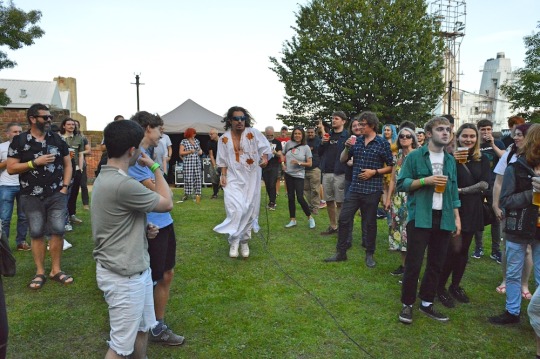
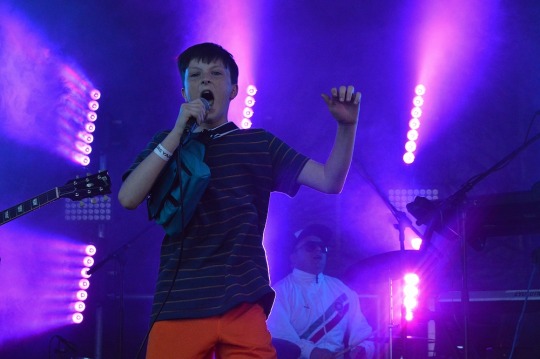

There's usually a point where a festival really kicks off and it was a performance in the Priory garden by The Intergalactic Republic of Kongo that really got Future Yard going after somewhat slow-ish start. With the audience hesitant to come too closer, IRoK vocalist and driving force Mike Title jumped over the railings and practically dragged everyone forward.
Dealing in a mix of Afrofuturism and early 90's dance-rock, the highlight was when they called a young kid up on stage and let him take over vocal duties for one of the songs. The young lad enjoyed himself so much that you thought they might have had a job on their hands getting the microphone back off him.
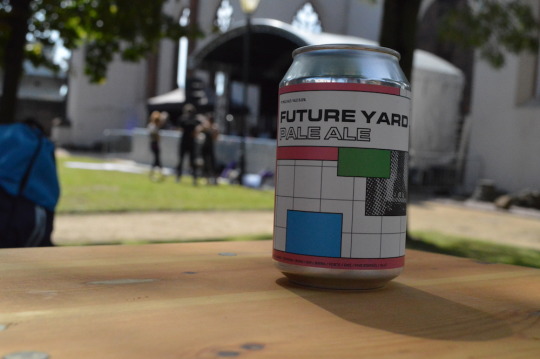

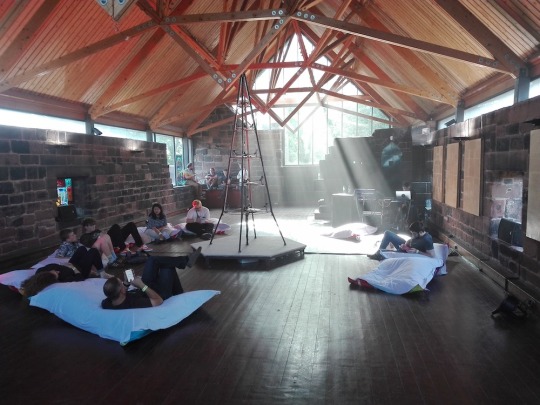

Given the hype starting to grow around the London-based six-piece over the past year, you'd have thought Black Country, New Road would have attracted a larger audience than they did in the Priory garden. Some sound issues delayed things by about ten minutes but their performance was easily one of the best of the weekend.
Their sound is an experimental blend of post-punk, noise rock, jazz and Balkan folk, which can perhaps best described as listening to Swans, Slint, Tortoise and King Crimson all at once, with a tense and fearful David Byrne-esque character on vocals. Cacophonous and incredibly gripping, the sax and violin really add to the dark tension they create. Keep your eye on this band.
The Priory garden cleared out pretty quickly as the majority of people headed off to check out what was on at the Town Hall and the Bloom Building. However, it soon filled back up as new faces arrived to catch Australian singer-songwriter Stella Donnelly. Unsure whether to stick or twist, the kind offer of a beer from a fellow festival goer persuaded us to stick and we were very glad that we did.



Connected to the area via her Welsh mother, Stella Donnelly performed a few tracks solo before being joined by her bandmates. Having not been that impressed with her album Beware of the Dogs earlier in the year, she was brilliant live and put in perhaps the funniest show of the weekend. Sharp and very witty, the chemistry she has with her band was also great to witness. It was a pleasure to be proven wrong.
After spending most of the day at the Priory it was about time to check out the Bloom Building properly. Conveniently only a minute down the road, it was quite packed down when we'd poked our heads in earlier on. Holding around a hundred-or-so max with extra space outside, the audience at the brightly coloured converted industrial unit tended to be younger on average than those in and around the Priory.
Although this wasn't the case for experimental trio Szun Waves, with the crowd being a little older but also fairly sparse during parts of their fifty minute set. Made up of electronic producer Luke Abbott, Laurence Pike of PVT on drums and Jack Wyllie of Portico Quartet on sax, their psychedelic electronic jazz explorations were perhaps a little too experimental for most of those who popped their heads in and out at various times.
Bill Ryder-Jones took to the stage in the Town Hall as the Friday night headline act and seemed a little wobbly after one too ales throughout the day. Despite this though it didn't prevent him and his band from putting in a great performance, with the shoegazey and slowcore blend of 'Satellites' being one of a number of standout tracks in their ninety minute set.
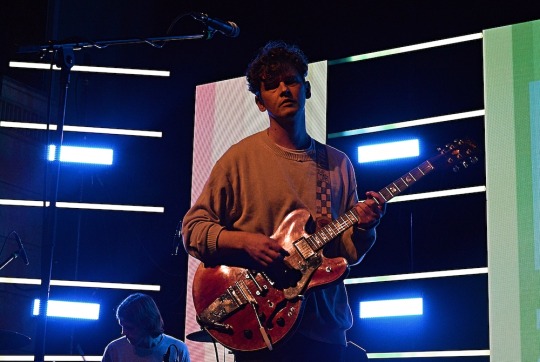
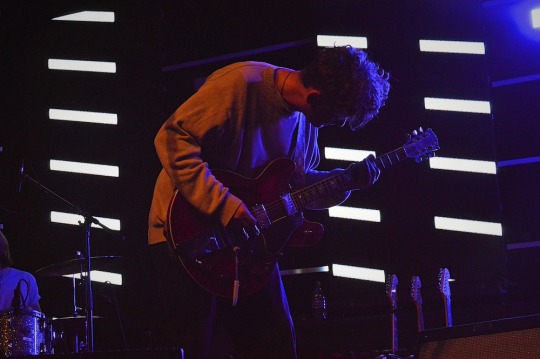


After recognising numerous family and friends dotted around in the audience, he joked about how it's nice that the locals don't have to get a taxi back across the river after watching live music for once. After a bit more piss taking he uttered "no divisions" with a wry smile. But it wasn't an inter-city rivalry which divided the room, it was the large numbers of people at the back insisting on chattering constantly throughout his performance, with Jones asking them to keep quiet numerous occasions.
SATURDAY
Day two began very early for some with a two hour bike tour. Titled 'Viking Wirral on Wheels' it was scheduled to depart the Priory gates at 10:30am. How many people made it we have no idea, but we spotted a group of about two dozen heading out on a walking tour just after 1pm led by a local historian. Preferring something a bit more relaxing, we sat back and watched some yoga in the Priory garden and had a look at the Saturday's offerings.
Kicking off the second day of music at the Priory was a programme curated by Focus Wales, an annual festival held in Wrexham which showcases the finest in Welsh talent. Opening this was Flintshire-born melodic soundscape artist Meilir who hopped between an electronic piano, an acoustic guitar and a typewriter, with his most powerful instrument being his stunning vocals.
In addition, the Focus Wales showcase included performances by Cardiff-based electronic pop artist Ani Glass (formerly of The Pipettes in which she performed with her sister of Gwenno Saunders), as well as electronic pop duo HMS Morris who were performing in Liverpool for only the second time.

Merging North Wales with Merseyside were seven-piece melancholic pop band Gintis, with members from both Abergele and Liverpool. Crowds were starting to pick up a bit by the time they performed just after 5pm and they certainly made the best of their time on stage on what was turning out to be a super hot day.
Despite the sun shining down we headed inside to the Priory Chapel to witness one of the highlights of the festival where Lo Five got the Reformat showcase rolling. The Liverpool-born, Hoylake-based electronic artist put together a seamless set of melodic, ambient techno-inspired tunes that had us hypnotised. We could easily have listened to another couple more hours of that.
Faced with a difficult choice, we went with Seatbelts down at the Town Hall over the highly rated Eyesore & the Jinx over at the Bloom Building. It was good to stretch our legs a bit after spending most of the day sat on the grass in the Priory garden. We certainly weren't the only ones who spent large parts of their weekend basking in the sun.

Assembled by Hooton Tennis Club songwriting duo James Madden and Ryan Murphy after they began writing tunes that were a little more experimental, their socially conscious songs are great fun live. Abi Woods on keys and vocals has been a great addition to this band, who with two solid EP's behind them are certainly one to keep an eye on.
Rather than walk ten minutes to the other venues only we grabbed a pint and waited for Beija Flo to enter the stage. It's pretty difficult to pick one standout act from the weekend as there were multiple but she has to be in the conversation. Her performance had everything, featuring a bit of poetry, comedy, dance and activism in between some great music.
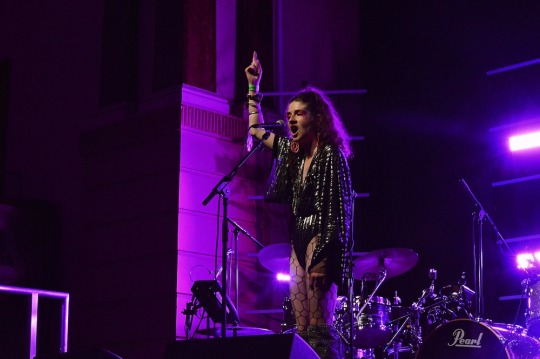
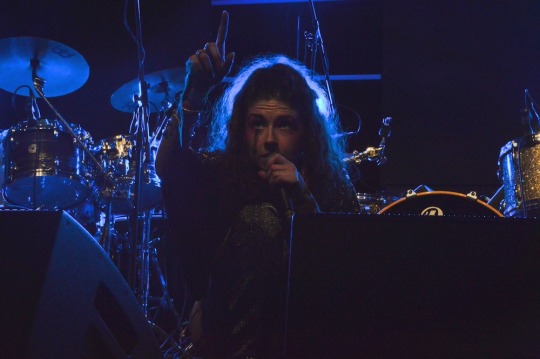
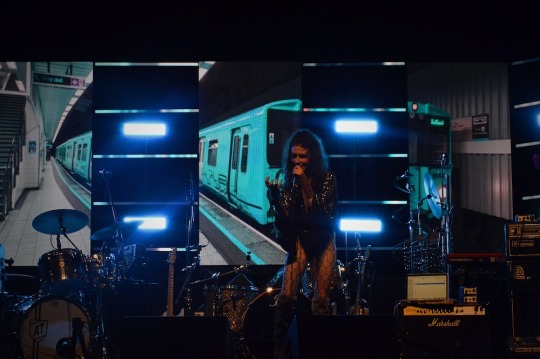
She puts so much of her personality into her art and had the full attention of everyone in the Town Hall, opening up at one point about her issues with MRKH Syndrome (a condition which causes the vagina and uterus to be underdeveloped or absent, affecting one in five thousand women). An incredibly original artist who has the potential to go very far indeed.
Line-up clashes are virtually inevitable at one point or another, especially with line-ups as good as Future Yard. It was certainly the case on Saturday evening. Pixx, Polypores and SPQR are all great and we were gutted that we were forced to miss them, but we just couldn't miss the opportunity to see Nilüfer Yanya perform in the Priory garden..
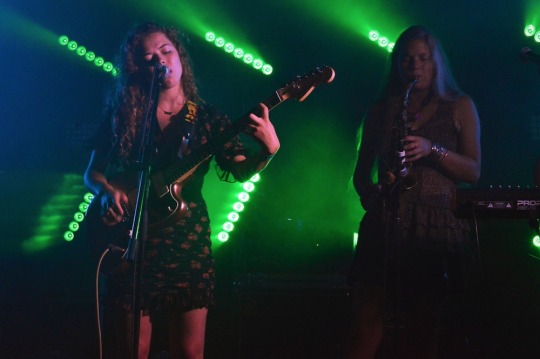


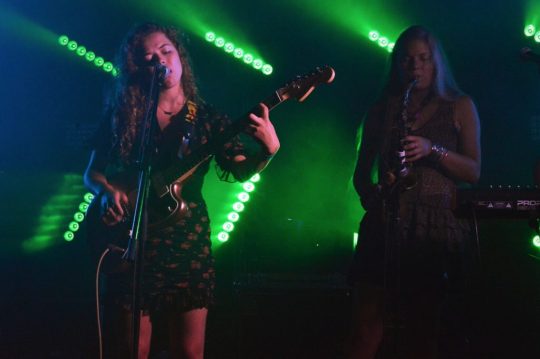
With the sun gone for another day, the 23-year old West London-born artist put in a fantastic performance. Playing tracks from her critically acclaimed full-length debut Miss Universe, the BBC Sound of 2018 nominee closed the Priory stage with her sophisticated blend of art pop, indie rock, soul, R&B and jazz. The sax playing was just superb.
With no other performances taking place during her Saturday night headline set, the entire festival headed over to the Town Hall to witness Anna Calvi. It didn't take very long to see why many were happy to pay for a ticket just to see the Mercury-nominated singer-songwriter. While her studio material is pretty good, live she is something else entirely. A force of nature.
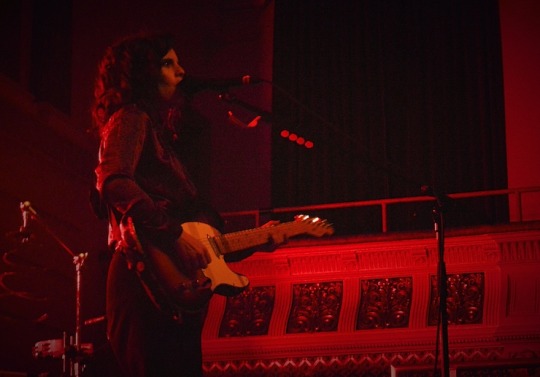


Dressed in her customary red shirt, black trousers and white boots, the power and passion of her performance and the way she holds a room with her Gothic-inspired vocals was quite incredible. Unlike the previous night, there was very little chattering during her ninety minute set which ended with a superb cover 'Ghost Rider' by Suicide.
Whether or not "The Future is Birkenhead", as the volunteer staff t-shirts said, only time will tell. Despite ticket sales perhaps not being quite as high as many would have hoped, the inaugural Future Yard was undoubtedly a huge success. Not one person we spoke to came away with anything other than love for this most intimate of festivals.
Read the full article
0 notes
Text
The ex-athlete brothers who signed Andy Murray now taking on the world with luxury sportswear brand Castore
The ex-athlete brothers who signed Andy Murray now taking on the world with luxury sportswear brand Castore
These Merseyside brothers quit their jobs as athletes to launch a premium sportswear brand now boasting British tennis legend Andy Murray as shareholder and partner – selling their products in more than 50 countries worldwide.
It’s been a whirlwind few years for Phil and Tom Beahon from the Wirral , who head up Castore, a brand experiencing increasingly dizzy heights.
Not only have Phil, 27, and…
View On WordPress
0 notes
Link
from Skem News – The Top Source for Skelmersdale News
0 notes
Photo

Bath fizzers 2 x 100g The perfect gift! Drop a half of the bath fizzer into the water and watch as it fizzes and releases its rich fragrance into the air. Softens and perfumes the bath water, leaving the skin gently fragrant. Even suitable for use in hot tubs! Comes cellophane wrapped and tied with raffia. Two semi spherical fizzers wrapped together (together slightly larger than a tennis ball).#bath #bathbombs #bath #lush #lushbathbomb #fizz #wirral #liverpool #fun #relaxing (at Amour Fizz Bombs)
0 notes
Text
8 incredible parks created from landfills
Humanity has turned Earth into a giant trash pile. The Environmental Protection Agency estimates that Americans alone produce on average 4.3 pounds of trash each day. Multiplied by 318.9 million people, that’s a lot of trash landing up in the country’s landfills. If there are about 3,500 active landfills in the United States, just one country, think about how many formal and informal landfills there are globally, leaching all kinds of nasty chemicals into ground and surface water supplies and emitting methane gases. It’s a daunting thought. But there is good news. As our knowledge of managing waste improves, we are learning to turn trash into a resource. For example, many landfill sites convert methane emissions into clean energy and many retired landfills have been safely rehabilitated into thriving public parks that reveal nothing of their trashy history. We have rounded up a list of 8. Prepare to be amazed by the transformation.
1. Mt. Trashmore, Virginia Beach
Talk about turning trash into treasure. The satirically named Mount Trashmore went from a devastating brownfield to becoming Virginia’s most popular park, with a children’s playground and a world-famous skate park. Tony Hawk, among several other professional skateboarders, have glided through its 24,000-square-foot skate park in front of packed crowds, and the park itself attracts over one million visitors annually. Situated upon mounds of compacted trash and topped with a layer of clean soil, its lush areas span upwards of 165 acres, with massive hills that stretch 60 feet high and cover over 800 feet of ground.
2. Hiriya Park, Tel-Aviv, Israel
Tel Aviv’s former landfill, called Hiriya was a horrifying mountain of garbage that was know affectionately to locals as “Sh!t Mountain”. This notorious garbage dump hit its limit in 1998 after reaching 25 million tons of waste. After that the facility was finally shut down and an international competition was held to prevent collapse of the waste into the Ayalon riverbed and resurrect the land into what is now the centerpiece of Ariel Sharon Park. Landscape architect and urban planner Peter Latz conceived a plan to protect vegetation from the underlying contaminants, inventing a bioplastic layer that inhibits methane from reaching the surface.
3. Sai Tso Wan Recreation Ground, Hong Kong
Sai Tso Wan’s multipurpose playground was the first of its kind to be constructed from a landfill in Hong Kong. It is also one of the greenest spaces in the region, hosting solar panels, wind turbines, rainwater irrigation, and recycled porous Rubbersoil. Its also the official training grounds of the Hong Kong Baseball Association.
4. Pulau Semaku, Singapore
Although Pulau Semaku is still a fully functioning landfill, and Singapore’s only landfill to boot, it was opened to the public in 2005 for selected recreational activities and still maintains bounds of vegetation in its surroundings areas. Perhaps the most fascinating aspects of Pulau Semaku are its thriving coral reefs and mangroves. Conscious and consistent efforts have been made to replant and maintain the existing reefs, flora and fauna, and wildlife continues to thrive in the site’s mangroves and western shorelines.
Image via Daniel Ramirez
5. Cesar Chavez Park, Berkeley
César Chávez Park is a waterfront hillside retreat off the coast of the San Francisco Bay, with spectacular views of the Golden Gate Bridge, Alcatraz, and Angel Island off in the distance. Its long stretches of grassy fields make it a premier area for kite flying and frisbee, with thousands attending the Berkeley Kite Festival at César Chávez every July. From hiking trails to a full-on wildlife sanctuary, the once dilapidated mountain of trash that existed in the 1950’s has now become a focal point of San Francisco culture.
Image via gkuna
6. Port Sunlight River Park, United Kingdom
Port River Sunlight Park is a rehabilitated riverside park that was brought to life on the UK’s Wirral coast. After 15 years as a landfill, landscape architecture firm Gillespies designed 70-acres of thriving community woodlands with over 12,000 trees. With views overlooking the Liverpool skyline and public access to the River Mersey, the sanctuary has become home to abundant wildlife, wildflower meadows, grasslands, and wetlands.
7. Flushing Meadows, Long Island
New York’s world famous Flushing Meadows-Corona Park is the second largest park in the city, and most notably known for hosting the 20th century World Fairs as well as the US Open in tennis every year, but did you know that it was once a landfill? Moreover, before it was a brownfield it was originally a natural marshland that fed into Meadow Lake, the largest freshwater lake in New York City. Although it’s a bit disheartening to know that the area was once a wetland, the comeback to its current purpose is thoroughly inspiring.
8. Fresh Kills, Staten Island
In what may be the most inspiring transformation of them all, Freshkills Park is currently in transition from being the largest landfill in the entire world to a stunning 2,200 acre park, the largest park in all of New York City’s boroughs. Its dramatic transformation began in 2008 and is still undergoing construction, with an estimated completion in 2035. The landfill originally opened in 1947, and by 2001 it was predicted that if the operation continued, the garbage heap was destined to become the highest point on the East Coast. Plans are now in place for a multitude of recreational, educational and athletic resources, not to mention a 46-acre solar array with the capability of powering 2000 Staten Island homes.
from DIYS http://ift.tt/2oKthCK
0 notes
Photo

Wirral Indoor Tennis Centre-Play Point Sports
There are 6 indoor tennis courts at Wirral Indoor Tennis Centre. It provides tennis opportunities for all ages and abilities, from booking a court with a friend to participating in our award-winning tennis coaching programme.
#wirral tennis club#chester tennis club#tennis clubs chester#wirral tennis centre#hoole lawn tennis club#wirral tennis and sports centre#bidston tennis centre#hoole tennis club#chester lawn tennis club#wirral tennis & sports centre#tennis clubs wirral
2 notes
·
View notes
Text
8 incredible parks created from landfills
Humanity has turned Earth into a giant trash pile. The Environmental Protection Agency estimates that Americans alone produce on average 4.3 pounds of trash each day. Multiplied by 318.9 million people, that’s a lot of trash landing up in the country’s landfills. If there are about 3,500 active landfills in the United States, just one country, think about how many formal and informal landfills there are globally, leaching all kinds of nasty chemicals into ground and surface water supplies and emitting methane gases. It’s a daunting thought. But there is good news. As our knowledge of managing waste improves, we are learning to turn trash into a resource. For example, many landfill sites convert methane emissions into clean energy and many retired landfills have been safely rehabilitated into thriving public parks that reveal nothing of their trashy history. We have rounded up a list of 8. Prepare to be amazed by the transformation.
1. Mt. Trashmore, Virginia Beach
Talk about turning trash into treasure. The satirically named Mount Trashmore went from a devastating brownfield to becoming Virginia’s most popular park, with a children’s playground and a world-famous skate park. Tony Hawk, among several other professional skateboarders, have glided through its 24,000-square-foot skate park in front of packed crowds, and the park itself attracts over one million visitors annually. Situated upon mounds of compacted trash and topped with a layer of clean soil, its lush areas span upwards of 165 acres, with massive hills that stretch 60 feet high and cover over 800 feet of ground.
2. Hiriya Park, Tel-Aviv, Israel
Tel Aviv’s former landfill, called Hiriya was a horrifying mountain of garbage that was know affectionately to locals as “Sh!t Mountain”. This notorious garbage dump hit its limit in 1998 after reaching 25 million tons of waste. After that the facility was finally shut down and an international competition was held to prevent collapse of the waste into the Ayalon riverbed and resurrect the land into what is now the centerpiece of Ariel Sharon Park. Landscape architect and urban planner Peter Latz conceived a plan to protect vegetation from the underlying contaminants, inventing a bioplastic layer that inhibits methane from reaching the surface.
3. Sai Tso Wan Recreation Ground, Hong Kong
Sai Tso Wan’s multipurpose playground was the first of its kind to be constructed from a landfill in Hong Kong. It is also one of the greenest spaces in the region, hosting solar panels, wind turbines, rainwater irrigation, and recycled porous Rubbersoil. Its also the official training grounds of the Hong Kong Baseball Association.
4. Pulau Semaku, Singapore
Although Pulau Semaku is still a fully functioning landfill, and Singapore’s only landfill to boot, it was opened to the public in 2005 for selected recreational activities and still maintains bounds of vegetation in its surroundings areas. Perhaps the most fascinating aspects of Pulau Semaku are its thriving coral reefs and mangroves. Conscious and consistent efforts have been made to replant and maintain the existing reefs, flora and fauna, and wildlife continues to thrive in the site’s mangroves and western shorelines.
Image via Daniel Ramirez
5. Cesar Chavez Park, Berkeley
César Chávez Park is a waterfront hillside retreat off the coast of the San Francisco Bay, with spectacular views of the Golden Gate Bridge, Alcatraz, and Angel Island off in the distance. Its long stretches of grassy fields make it a premier area for kite flying and frisbee, with thousands attending the Berkeley Kite Festival at César Chávez every July. From hiking trails to a full-on wildlife sanctuary, the once dilapidated mountain of trash that existed in the 1950’s has now become a focal point of San Francisco culture.
Image via gkuna
6. Port Sunlight River Park, United Kingdom
Port River Sunlight Park is a rehabilitated riverside park that was brought to life on the UK’s Wirral coast. After 15 years as a landfill, landscape architecture firm Gillespies designed 70-acres of thriving community woodlands with over 12,000 trees. With views overlooking the Liverpool skyline and public access to the River Mersey, the sanctuary has become home to abundant wildlife, wildflower meadows, grasslands, and wetlands.
7. Flushing Meadows, Long Island
New York’s world famous Flushing Meadows-Corona Park is the second largest park in the city, and most notably known for hosting the 20th century World Fairs as well as the US Open in tennis every year, but did you know that it was once a landfill? Moreover, before it was a brownfield it was originally a natural marshland that fed into Meadow Lake, the largest freshwater lake in New York City. Although it’s a bit disheartening to know that the area was once a wetland, the comeback to its current purpose is thoroughly inspiring.
8. Fresh Kills, Staten Island
In what may be the most inspiring transformation of them all, Freshkills Park is currently in transition from being the largest landfill in the entire world to a stunning 2,200 acre park, the largest park in all of New York City’s boroughs. Its dramatic transformation began in 2008 and is still undergoing construction, with an estimated completion in 2035. The landfill originally opened in 1947, and by 2001 it was predicted that if the operation continued, the garbage heap was destined to become the highest point on the East Coast. Plans are now in place for a multitude of recreational, educational and athletic resources, not to mention a 46-acre solar array with the capability of powering 2000 Staten Island homes.
from DIYS http://ift.tt/2oKthCK
0 notes
Text
8 incredible parks created from landfills
Humanity has turned Earth into a giant trash pile. The Environmental Protection Agency estimates that Americans alone produce on average 4.3 pounds of trash each day. Multiplied by 318.9 million people, that’s a lot of trash landing up in the country’s landfills. If there are about 3,500 active landfills in the United States, just one country, think about how many formal and informal landfills there are globally, leaching all kinds of nasty chemicals into ground and surface water supplies and emitting methane gases. It’s a daunting thought. But there is good news. As our knowledge of managing waste improves, we are learning to turn trash into a resource. For example, many landfill sites convert methane emissions into clean energy and many retired landfills have been safely rehabilitated into thriving public parks that reveal nothing of their trashy history. We have rounded up a list of 8. Prepare to be amazed by the transformation.
1. Mt. Trashmore, Virginia Beach
Talk about turning trash into treasure. The satirically named Mount Trashmore went from a devastating brownfield to becoming Virginia’s most popular park, with a children’s playground and a world-famous skate park. Tony Hawk, among several other professional skateboarders, have glided through its 24,000-square-foot skate park in front of packed crowds, and the park itself attracts over one million visitors annually. Situated upon mounds of compacted trash and topped with a layer of clean soil, its lush areas span upwards of 165 acres, with massive hills that stretch 60 feet high and cover over 800 feet of ground.
2. Hiriya Park, Tel-Aviv, Israel
Tel Aviv’s former landfill, called Hiriya was a horrifying mountain of garbage that was know affectionately to locals as “Sh!t Mountain”. This notorious garbage dump hit its limit in 1998 after reaching 25 million tons of waste. After that the facility was finally shut down and an international competition was held to prevent collapse of the waste into the Ayalon riverbed and resurrect the land into what is now the centerpiece of Ariel Sharon Park. Landscape architect and urban planner Peter Latz conceived a plan to protect vegetation from the underlying contaminants, inventing a bioplastic layer that inhibits methane from reaching the surface.
3. Sai Tso Wan Recreation Ground, Hong Kong
Sai Tso Wan’s multipurpose playground was the first of its kind to be constructed from a landfill in Hong Kong. It is also one of the greenest spaces in the region, hosting solar panels, wind turbines, rainwater irrigation, and recycled porous Rubbersoil. Its also the official training grounds of the Hong Kong Baseball Association.
4. Pulau Semaku, Singapore
Although Pulau Semaku is still a fully functioning landfill, and Singapore’s only landfill to boot, it was opened to the public in 2005 for selected recreational activities and still maintains bounds of vegetation in its surroundings areas. Perhaps the most fascinating aspects of Pulau Semaku are its thriving coral reefs and mangroves. Conscious and consistent efforts have been made to replant and maintain the existing reefs, flora and fauna, and wildlife continues to thrive in the site’s mangroves and western shorelines.
Image via Daniel Ramirez
5. Cesar Chavez Park, Berkeley
César Chávez Park is a waterfront hillside retreat off the coast of the San Francisco Bay, with spectacular views of the Golden Gate Bridge, Alcatraz, and Angel Island off in the distance. Its long stretches of grassy fields make it a premier area for kite flying and frisbee, with thousands attending the Berkeley Kite Festival at César Chávez every July. From hiking trails to a full-on wildlife sanctuary, the once dilapidated mountain of trash that existed in the 1950’s has now become a focal point of San Francisco culture.
Image via gkuna
6. Port Sunlight River Park, United Kingdom
Port River Sunlight Park is a rehabilitated riverside park that was brought to life on the UK’s Wirral coast. After 15 years as a landfill, landscape architecture firm Gillespies designed 70-acres of thriving community woodlands with over 12,000 trees. With views overlooking the Liverpool skyline and public access to the River Mersey, the sanctuary has become home to abundant wildlife, wildflower meadows, grasslands, and wetlands.
7. Flushing Meadows, Long Island
New York’s world famous Flushing Meadows-Corona Park is the second largest park in the city, and most notably known for hosting the 20th century World Fairs as well as the US Open in tennis every year, but did you know that it was once a landfill? Moreover, before it was a brownfield it was originally a natural marshland that fed into Meadow Lake, the largest freshwater lake in New York City. Although it’s a bit disheartening to know that the area was once a wetland, the comeback to its current purpose is thoroughly inspiring.
8. Fresh Kills, Staten Island
In what may be the most inspiring transformation of them all, Freshkills Park is currently in transition from being the largest landfill in the entire world to a stunning 2,200 acre park, the largest park in all of New York City’s boroughs. Its dramatic transformation began in 2008 and is still undergoing construction, with an estimated completion in 2035. The landfill originally opened in 1947, and by 2001 it was predicted that if the operation continued, the garbage heap was destined to become the highest point on the East Coast. Plans are now in place for a multitude of recreational, educational and athletic resources, not to mention a 46-acre solar array with the capability of powering 2000 Staten Island homes.
from DIYS http://ift.tt/2oKthCK
0 notes
Text
8 incredible parks created from landfills
Humanity has turned Earth into a giant trash pile. The Environmental Protection Agency estimates that Americans alone produce on average 4.3 pounds of trash each day. Multiplied by 318.9 million people, that’s a lot of trash landing up in the country’s landfills. If there are about 3,500 active landfills in the United States, just one country, think about how many formal and informal landfills there are globally, leaching all kinds of nasty chemicals into ground and surface water supplies and emitting methane gases. It’s a daunting thought. But there is good news. As our knowledge of managing waste improves, we are learning to turn trash into a resource. For example, many landfill sites convert methane emissions into clean energy and many retired landfills have been safely rehabilitated into thriving public parks that reveal nothing of their trashy history. We have rounded up a list of 8. Prepare to be amazed by the transformation.
1. Mt. Trashmore, Virginia Beach
Talk about turning trash into treasure. The satirically named Mount Trashmore went from a devastating brownfield to becoming Virginia’s most popular park, with a children’s playground and a world-famous skate park. Tony Hawk, among several other professional skateboarders, have glided through its 24,000-square-foot skate park in front of packed crowds, and the park itself attracts over one million visitors annually. Situated upon mounds of compacted trash and topped with a layer of clean soil, its lush areas span upwards of 165 acres, with massive hills that stretch 60 feet high and cover over 800 feet of ground.
2. Hiriya Park, Tel-Aviv, Israel
Tel Aviv’s former landfill, called Hiriya was a horrifying mountain of garbage that was know affectionately to locals as “Sh!t Mountain”. This notorious garbage dump hit its limit in 1998 after reaching 25 million tons of waste. After that the facility was finally shut down and an international competition was held to prevent collapse of the waste into the Ayalon riverbed and resurrect the land into what is now the centerpiece of Ariel Sharon Park. Landscape architect and urban planner Peter Latz conceived a plan to protect vegetation from the underlying contaminants, inventing a bioplastic layer that inhibits methane from reaching the surface.
3. Sai Tso Wan Recreation Ground, Hong Kong
Sai Tso Wan’s multipurpose playground was the first of its kind to be constructed from a landfill in Hong Kong. It is also one of the greenest spaces in the region, hosting solar panels, wind turbines, rainwater irrigation, and recycled porous Rubbersoil. Its also the official training grounds of the Hong Kong Baseball Association.
4. Pulau Semaku, Singapore
Although Pulau Semaku is still a fully functioning landfill, and Singapore’s only landfill to boot, it was opened to the public in 2005 for selected recreational activities and still maintains bounds of vegetation in its surroundings areas. Perhaps the most fascinating aspects of Pulau Semaku are its thriving coral reefs and mangroves. Conscious and consistent efforts have been made to replant and maintain the existing reefs, flora and fauna, and wildlife continues to thrive in the site’s mangroves and western shorelines.
Image via Daniel Ramirez
5. Cesar Chavez Park, Berkeley
César Chávez Park is a waterfront hillside retreat off the coast of the San Francisco Bay, with spectacular views of the Golden Gate Bridge, Alcatraz, and Angel Island off in the distance. Its long stretches of grassy fields make it a premier area for kite flying and frisbee, with thousands attending the Berkeley Kite Festival at César Chávez every July. From hiking trails to a full-on wildlife sanctuary, the once dilapidated mountain of trash that existed in the 1950’s has now become a focal point of San Francisco culture.
Image via gkuna
6. Port Sunlight River Park, United Kingdom
Port River Sunlight Park is a rehabilitated riverside park that was brought to life on the UK’s Wirral coast. After 15 years as a landfill, landscape architecture firm Gillespies designed 70-acres of thriving community woodlands with over 12,000 trees. With views overlooking the Liverpool skyline and public access to the River Mersey, the sanctuary has become home to abundant wildlife, wildflower meadows, grasslands, and wetlands.
7. Flushing Meadows, Long Island
New York’s world famous Flushing Meadows-Corona Park is the second largest park in the city, and most notably known for hosting the 20th century World Fairs as well as the US Open in tennis every year, but did you know that it was once a landfill? Moreover, before it was a brownfield it was originally a natural marshland that fed into Meadow Lake, the largest freshwater lake in New York City. Although it’s a bit disheartening to know that the area was once a wetland, the comeback to its current purpose is thoroughly inspiring.
8. Fresh Kills, Staten Island
In what may be the most inspiring transformation of them all, Freshkills Park is currently in transition from being the largest landfill in the entire world to a stunning 2,200 acre park, the largest park in all of New York City’s boroughs. Its dramatic transformation began in 2008 and is still undergoing construction, with an estimated completion in 2035. The landfill originally opened in 1947, and by 2001 it was predicted that if the operation continued, the garbage heap was destined to become the highest point on the East Coast. Plans are now in place for a multitude of recreational, educational and athletic resources, not to mention a 46-acre solar array with the capability of powering 2000 Staten Island homes.
from DIYS http://ift.tt/2oKthCK
0 notes
Text
Future Yard ‘In Their Own Words’ – Seatbelts
Songwriting duo James Madden and Ryan Murphy have been making guitar pop together for the best part of a decade, previously as one half of the popular Hooton Tennis Club (currently on indefinite hiatus), and now as the wry, socially observant Seatbelts.
The birth of Seatbelts can be traced back to late 2017, when songs they were writing together started to take on a different, more experimental form. Not feeling that they were very well suited to their old band, they formed a new band through which to channel them.
Joining forces with Abi Woods (keys, vocals) and Alex Quinn (drums), they released their Kurt Vonnegut-inspired debut EP Songs For Vonnegut last summer. Wasting very little time, they followed it up with another EP this past April in the form of the excellent Please Slow Down.
In the sixth of our series of interviews with the Future Yard line-up, we spoke to Seatbelts about their music and their upcoming appearance at the festival.
For someone who may never have come across your work before, how would you describe your music? And if you could recommend them one of your songs, which one would that be?
Seatbelts make song-driven, melodic music. Full of surprises, with sounds that bring about a post-punk party atmosphere, and lyrics to get you thinking. A combination of singers create unpredictable vocal lines delivered with verve and belief. With this being said, we would recommend you start by listening to ‘Spanish Songs’ from our most recent EP Please Slow Down.
https://www.youtube.com/watch?v=d-8rxYBtsCw
Who or what have been the biggest influences on your sound?
Casio, Parr Street, Scotland, heartbreak, Europe, vogue, SEX & sensitivity, cowbells, Postcard Records, Godard, capitalism.
How well do you know Birkenhead and wider Wirral area?
We played and made a bootleg recording at Fresh Goods Studio in 2018. Some of us of nearly from the Wirral. One of us works at the pierhead and looks at Birkenhead everyday. It’s said to be the Brooklyn to our New York.
What’s your favourite festival memory, either as a performer or as a fan?
A double rainbow appeared over the mountain stage at Green Man whilst Connnan Mockasin was swooning the crowd. Also, a sing-along to ‘Shipbuilding’ at the Glastonbury Stone Circle one sunrise.
https://youtu.be/D-ghHq0dpmk
Apart from yourselves, who would you recommend people go see at Future Yard?
Bill Ryder-Jones, Audiobooks, SPQR, Strawberry Guy, and Bill Nickson.
Why should festival goers take time out to come and see you play? What can they expect from your performance at Future Yard?
We haven’t all been together since we travelled to the highlands in July, one of our members went off-grid to go and explore the Hebrides. We don’t know where they are or if they are alive, so we hope that when we play Future Yard our performance will have all the elements of a joyous reunion. Come along and find out if we got it together.
Seatbelts will be performing at Future Yard on Saturday 25th August in Birkenhead Town Hall at 19:15.
You can hear more music by Seatbelts over at Bandcamp. They can also be found on Facebook, Twitter and Instagram.
For more details about the festival, including how to purchase weekend and day tickets, head over to FutureYard.org

Read the full article
0 notes
Text
youtube
Watch the American Climate Leadership Awards 2024 now: https://youtu.be/bWiW4Rp8vF0?feature=shared
The American Climate Leadership Awards 2024 broadcast recording is now available on ecoAmerica's YouTube channel for viewers to be inspired by active climate leaders. Watch to find out which finalist received the $50,000 grand prize! Hosted by Vanessa Hauc and featuring Bill McKibben and Katharine Hayhoe!
#ACLA24#ACLA24Leaders#youtube#youtube video#climate leaders#climate solutions#climate action#climate and environment#climate#climate change#climate and health#climate blog#climate justice#climate news#weather and climate#environmental news#environment#environmental awareness#environment and health#environmental#environmental issues#environmental justice#environment protection#environmental health#Youtube
20K notes
·
View notes
Text
8 incredible parks created from landfills
Humanity has turned Earth into a giant trash pile. The Environmental Protection Agency estimates that Americans alone produce on average 4.3 pounds of trash each day. Multiplied by 318.9 million people, that’s a lot of trash landing up in the country’s landfills. If there are about 3,500 active landfills in the United States, just one country, think about how many formal and informal landfills there are globally, leaching all kinds of nasty chemicals into ground and surface water supplies and emitting methane gases. It’s a daunting thought. But there is good news. As our knowledge of managing waste improves, we are learning to turn trash into a resource. For example, many landfill sites convert methane emissions into clean energy and many retired landfills have been safely rehabilitated into thriving public parks that reveal nothing of their trashy history. We have rounded up a list of 8. Prepare to be amazed by the transformation.
1. Mt. Trashmore, Virginia Beach
Talk about turning trash into treasure. The satirically named Mount Trashmore went from a devastating brownfield to becoming Virginia’s most popular park, with a children’s playground and a world-famous skate park. Tony Hawk, among several other professional skateboarders, have glided through its 24,000-square-foot skate park in front of packed crowds, and the park itself attracts over one million visitors annually. Situated upon mounds of compacted trash and topped with a layer of clean soil, its lush areas span upwards of 165 acres, with massive hills that stretch 60 feet high and cover over 800 feet of ground.
2. Hiriya Park, Tel-Aviv, Israel
Tel Aviv’s former landfill, called Hiriya was a horrifying mountain of garbage that was know affectionately to locals as “Sh!t Mountain”. This notorious garbage dump hit its limit in 1998 after reaching 25 million tons of waste. After that the facility was finally shut down and an international competition was held to prevent collapse of the waste into the Ayalon riverbed and resurrect the land into what is now the centerpiece of Ariel Sharon Park. Landscape architect and urban planner Peter Latz conceived a plan to protect vegetation from the underlying contaminants, inventing a bioplastic layer that inhibits methane from reaching the surface.
3. Sai Tso Wan Recreation Ground, Hong Kong
Sai Tso Wan’s multipurpose playground was the first of its kind to be constructed from a landfill in Hong Kong. It is also one of the greenest spaces in the region, hosting solar panels, wind turbines, rainwater irrigation, and recycled porous Rubbersoil. Its also the official training grounds of the Hong Kong Baseball Association.
4. Pulau Semaku, Singapore
Although Pulau Semaku is still a fully functioning landfill, and Singapore’s only landfill to boot, it was opened to the public in 2005 for selected recreational activities and still maintains bounds of vegetation in its surroundings areas. Perhaps the most fascinating aspects of Pulau Semaku are its thriving coral reefs and mangroves. Conscious and consistent efforts have been made to replant and maintain the existing reefs, flora and fauna, and wildlife continues to thrive in the site’s mangroves and western shorelines.
Image via Daniel Ramirez
5. Cesar Chavez Park, Berkeley
César Chávez Park is a waterfront hillside retreat off the coast of the San Francisco Bay, with spectacular views of the Golden Gate Bridge, Alcatraz, and Angel Island off in the distance. Its long stretches of grassy fields make it a premier area for kite flying and frisbee, with thousands attending the Berkeley Kite Festival at César Chávez every July. From hiking trails to a full-on wildlife sanctuary, the once dilapidated mountain of trash that existed in the 1950’s has now become a focal point of San Francisco culture.
Image via gkuna
6. Port Sunlight River Park, United Kingdom
Port River Sunlight Park is a rehabilitated riverside park that was brought to life on the UK’s Wirral coast. After 15 years as a landfill, landscape architecture firm Gillespies designed 70-acres of thriving community woodlands with over 12,000 trees. With views overlooking the Liverpool skyline and public access to the River Mersey, the sanctuary has become home to abundant wildlife, wildflower meadows, grasslands, and wetlands.
7. Flushing Meadows, Long Island
New York’s world famous Flushing Meadows-Corona Park is the second largest park in the city, and most notably known for hosting the 20th century World Fairs as well as the US Open in tennis every year, but did you know that it was once a landfill? Moreover, before it was a brownfield it was originally a natural marshland that fed into Meadow Lake, the largest freshwater lake in New York City. Although it’s a bit disheartening to know that the area was once a wetland, the comeback to its current purpose is thoroughly inspiring.
8. Fresh Kills, Staten Island
In what may be the most inspiring transformation of them all, Freshkills Park is currently in transition from being the largest landfill in the entire world to a stunning 2,200 acre park, the largest park in all of New York City’s boroughs. Its dramatic transformation began in 2008 and is still undergoing construction, with an estimated completion in 2035. The landfill originally opened in 1947, and by 2001 it was predicted that if the operation continued, the garbage heap was destined to become the highest point on the East Coast. Plans are now in place for a multitude of recreational, educational and athletic resources, not to mention a 46-acre solar array with the capability of powering 2000 Staten Island homes.
from DIYS http://ift.tt/2oKthCK
0 notes
Text
8 incredible parks created from landfills
Humanity has turned Earth into a giant trash pile. The Environmental Protection Agency estimates that Americans alone produce on average 4.3 pounds of trash each day. Multiplied by 318.9 million people, that’s a lot of trash landing up in the country’s landfills. If there are about 3,500 active landfills in the United States, just one country, think about how many formal and informal landfills there are globally, leaching all kinds of nasty chemicals into ground and surface water supplies and emitting methane gases. It’s a daunting thought. But there is good news. As our knowledge of managing waste improves, we are learning to turn trash into a resource. For example, many landfill sites convert methane emissions into clean energy and many retired landfills have been safely rehabilitated into thriving public parks that reveal nothing of their trashy history. We have rounded up a list of 8. Prepare to be amazed by the transformation.
1. Mt. Trashmore, Virginia Beach
Talk about turning trash into treasure. The satirically named Mount Trashmore went from a devastating brownfield to becoming Virginia’s most popular park, with a children’s playground and a world-famous skate park. Tony Hawk, among several other professional skateboarders, have glided through its 24,000-square-foot skate park in front of packed crowds, and the park itself attracts over one million visitors annually. Situated upon mounds of compacted trash and topped with a layer of clean soil, its lush areas span upwards of 165 acres, with massive hills that stretch 60 feet high and cover over 800 feet of ground.
2. Hiriya Park, Tel-Aviv, Israel
Tel Aviv’s former landfill, called Hiriya was a horrifying mountain of garbage that was know affectionately to locals as “Sh!t Mountain”. This notorious garbage dump hit its limit in 1998 after reaching 25 million tons of waste. After that the facility was finally shut down and an international competition was held to prevent collapse of the waste into the Ayalon riverbed and resurrect the land into what is now the centerpiece of Ariel Sharon Park. Landscape architect and urban planner Peter Latz conceived a plan to protect vegetation from the underlying contaminants, inventing a bioplastic layer that inhibits methane from reaching the surface.
3. Sai Tso Wan Recreation Ground, Hong Kong
Sai Tso Wan’s multipurpose playground was the first of its kind to be constructed from a landfill in Hong Kong. It is also one of the greenest spaces in the region, hosting solar panels, wind turbines, rainwater irrigation, and recycled porous Rubbersoil. Its also the official training grounds of the Hong Kong Baseball Association.
4. Pulau Semaku, Singapore
Although Pulau Semaku is still a fully functioning landfill, and Singapore’s only landfill to boot, it was opened to the public in 2005 for selected recreational activities and still maintains bounds of vegetation in its surroundings areas. Perhaps the most fascinating aspects of Pulau Semaku are its thriving coral reefs and mangroves. Conscious and consistent efforts have been made to replant and maintain the existing reefs, flora and fauna, and wildlife continues to thrive in the site’s mangroves and western shorelines.
Image via Daniel Ramirez
5. Cesar Chavez Park, Berkeley
César Chávez Park is a waterfront hillside retreat off the coast of the San Francisco Bay, with spectacular views of the Golden Gate Bridge, Alcatraz, and Angel Island off in the distance. Its long stretches of grassy fields make it a premier area for kite flying and frisbee, with thousands attending the Berkeley Kite Festival at César Chávez every July. From hiking trails to a full-on wildlife sanctuary, the once dilapidated mountain of trash that existed in the 1950’s has now become a focal point of San Francisco culture.
Image via gkuna
6. Port Sunlight River Park, United Kingdom
Port River Sunlight Park is a rehabilitated riverside park that was brought to life on the UK’s Wirral coast. After 15 years as a landfill, landscape architecture firm Gillespies designed 70-acres of thriving community woodlands with over 12,000 trees. With views overlooking the Liverpool skyline and public access to the River Mersey, the sanctuary has become home to abundant wildlife, wildflower meadows, grasslands, and wetlands.
7. Flushing Meadows, Long Island
New York’s world famous Flushing Meadows-Corona Park is the second largest park in the city, and most notably known for hosting the 20th century World Fairs as well as the US Open in tennis every year, but did you know that it was once a landfill? Moreover, before it was a brownfield it was originally a natural marshland that fed into Meadow Lake, the largest freshwater lake in New York City. Although it’s a bit disheartening to know that the area was once a wetland, the comeback to its current purpose is thoroughly inspiring.
8. Fresh Kills, Staten Island
In what may be the most inspiring transformation of them all, Freshkills Park is currently in transition from being the largest landfill in the entire world to a stunning 2,200 acre park, the largest park in all of New York City’s boroughs. Its dramatic transformation began in 2008 and is still undergoing construction, with an estimated completion in 2035. The landfill originally opened in 1947, and by 2001 it was predicted that if the operation continued, the garbage heap was destined to become the highest point on the East Coast. Plans are now in place for a multitude of recreational, educational and athletic resources, not to mention a 46-acre solar array with the capability of powering 2000 Staten Island homes.
from DIYS http://ift.tt/2oKthCK
0 notes
Photo

Tennis Training Equipment
1. Resistance Bands
2. Foam rollers
3. Reaction Ball
4. TRX or Suspension Straps
5. Medicine Ball
6. Agility Belts
#wirral tennis club#tennis clubs chester#wirral tennis centre#hoole lawn tennis club#wirral tennis and sports centre#bidston tennis centre#hoole tennis club#chester lawn tennis club#wirral tennis & sports centre
0 notes
Text
8 incredible parks created from landfills
Humanity has turned Earth into a giant trash pile. The Environmental Protection Agency estimates that Americans alone produce on average 4.3 pounds of trash each day. Multiplied by 318.9 million people, that’s a lot of trash landing up in the country’s landfills. If there are about 3,500 active landfills in the United States, just one country, think about how many formal and informal landfills there are globally, leaching all kinds of nasty chemicals into ground and surface water supplies and emitting methane gases. It’s a daunting thought. But there is good news. As our knowledge of managing waste improves, we are learning to turn trash into a resource. For example, many landfill sites convert methane emissions into clean energy and many retired landfills have been safely rehabilitated into thriving public parks that reveal nothing of their trashy history. We have rounded up a list of 8. Prepare to be amazed by the transformation.
1. Mt. Trashmore, Virginia Beach
Talk about turning trash into treasure. The satirically named Mount Trashmore went from a devastating brownfield to becoming Virginia’s most popular park, with a children’s playground and a world-famous skate park. Tony Hawk, among several other professional skateboarders, have glided through its 24,000-square-foot skate park in front of packed crowds, and the park itself attracts over one million visitors annually. Situated upon mounds of compacted trash and topped with a layer of clean soil, its lush areas span upwards of 165 acres, with massive hills that stretch 60 feet high and cover over 800 feet of ground.
2. Hiriya Park, Tel-Aviv, Israel
Tel Aviv’s former landfill, called Hiriya was a horrifying mountain of garbage that was know affectionately to locals as “Sh!t Mountain”. This notorious garbage dump hit its limit in 1998 after reaching 25 million tons of waste. After that the facility was finally shut down and an international competition was held to prevent collapse of the waste into the Ayalon riverbed and resurrect the land into what is now the centerpiece of Ariel Sharon Park. Landscape architect and urban planner Peter Latz conceived a plan to protect vegetation from the underlying contaminants, inventing a bioplastic layer that inhibits methane from reaching the surface.
3. Sai Tso Wan Recreation Ground, Hong Kong
Sai Tso Wan’s multipurpose playground was the first of its kind to be constructed from a landfill in Hong Kong. It is also one of the greenest spaces in the region, hosting solar panels, wind turbines, rainwater irrigation, and recycled porous Rubbersoil. Its also the official training grounds of the Hong Kong Baseball Association.
4. Pulau Semaku, Singapore
Although Pulau Semaku is still a fully functioning landfill, and Singapore’s only landfill to boot, it was opened to the public in 2005 for selected recreational activities and still maintains bounds of vegetation in its surroundings areas. Perhaps the most fascinating aspects of Pulau Semaku are its thriving coral reefs and mangroves. Conscious and consistent efforts have been made to replant and maintain the existing reefs, flora and fauna, and wildlife continues to thrive in the site’s mangroves and western shorelines.
Image via Daniel Ramirez
5. Cesar Chavez Park, Berkeley
César Chávez Park is a waterfront hillside retreat off the coast of the San Francisco Bay, with spectacular views of the Golden Gate Bridge, Alcatraz, and Angel Island off in the distance. Its long stretches of grassy fields make it a premier area for kite flying and frisbee, with thousands attending the Berkeley Kite Festival at César Chávez every July. From hiking trails to a full-on wildlife sanctuary, the once dilapidated mountain of trash that existed in the 1950’s has now become a focal point of San Francisco culture.
Image via gkuna
6. Port Sunlight River Park, United Kingdom
Port River Sunlight Park is a rehabilitated riverside park that was brought to life on the UK’s Wirral coast. After 15 years as a landfill, landscape architecture firm Gillespies designed 70-acres of thriving community woodlands with over 12,000 trees. With views overlooking the Liverpool skyline and public access to the River Mersey, the sanctuary has become home to abundant wildlife, wildflower meadows, grasslands, and wetlands.
7. Flushing Meadows, Long Island
New York’s world famous Flushing Meadows-Corona Park is the second largest park in the city, and most notably known for hosting the 20th century World Fairs as well as the US Open in tennis every year, but did you know that it was once a landfill? Moreover, before it was a brownfield it was originally a natural marshland that fed into Meadow Lake, the largest freshwater lake in New York City. Although it’s a bit disheartening to know that the area was once a wetland, the comeback to its current purpose is thoroughly inspiring.
8. Fresh Kills, Staten Island
In what may be the most inspiring transformation of them all, Freshkills Park is currently in transition from being the largest landfill in the entire world to a stunning 2,200 acre park, the largest park in all of New York City’s boroughs. Its dramatic transformation began in 2008 and is still undergoing construction, with an estimated completion in 2035. The landfill originally opened in 1947, and by 2001 it was predicted that if the operation continued, the garbage heap was destined to become the highest point on the East Coast. Plans are now in place for a multitude of recreational, educational and athletic resources, not to mention a 46-acre solar array with the capability of powering 2000 Staten Island homes.
from DIYS http://ift.tt/2oKthCK
0 notes
Text
youtube
Watch the 2024 American Climate Leadership Awards for High School Students now: https://youtu.be/5C-bb9PoRLc
The recording is now available on ecoAmerica's YouTube channel for viewers to be inspired by student climate leaders! Join Aishah-Nyeta Brown & Jerome Foster II and be inspired by student climate leaders as we recognize the High School Student finalists. Watch now to find out which student received the $25,000 grand prize and top recognition!
#ACLA24#ACLA24HighSchoolStudents#youtube#youtube video#climate leaders#climate solutions#climate action#climate and environment#climate#climate change#climate and health#climate blog#climate justice#climate news#weather and climate#environmental news#environment#environmental awareness#environment and health#environmental#environmental issues#environmental education#environmental justice#environmental protection#environmental health#high school students#high school#youth#youth of america#school
20K notes
·
View notes